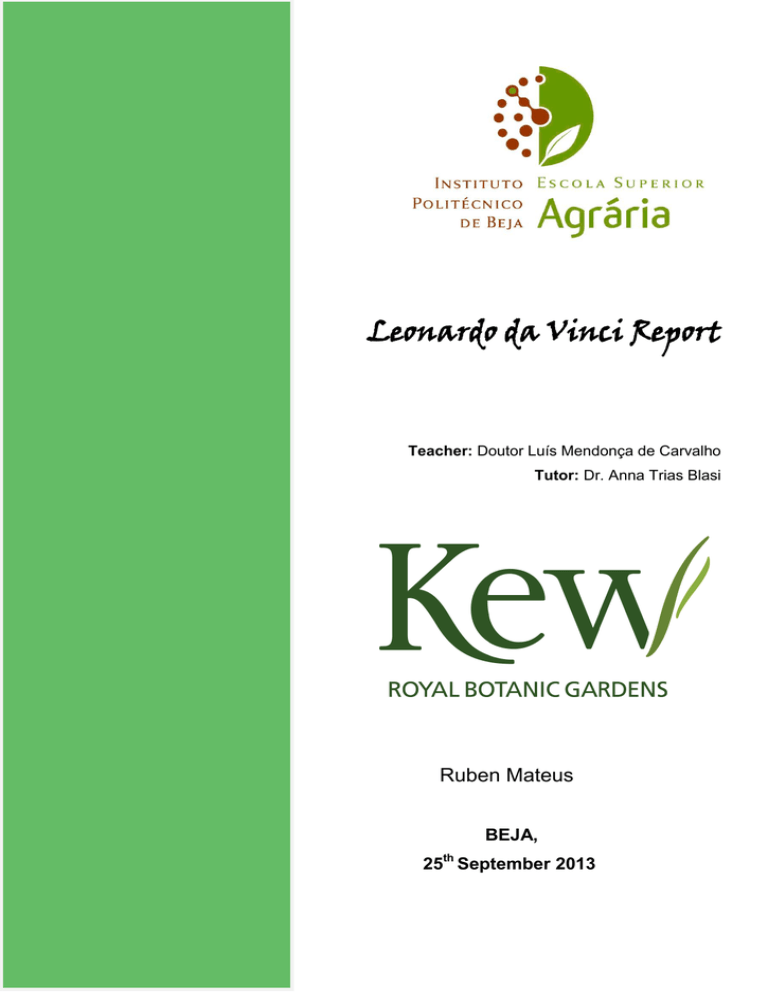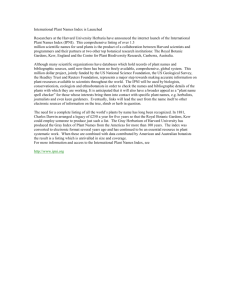Leonardo da Vinci Report
advertisement

Leonardo da Vinci Report Teacher: Doutor Luís Mendonça de Carvalho Tutor: Dr. Anna Trias Blasi Ruben Mateus BEJA, 25th September 2013 Introduction The following report describes my Leonardo da Vinci mobility program which took place in the Royal Botanic Gardens, Kew (United Kingdom) during six months. The European Union program Leonardo da Vinci is a mobility program, which offers the opportunity to supplement and improve the vocational training, facilitate the access to a different culture, new operating procedures and different ways of organizing the work through an internship. The potential beneficiaries of the Leonardo da Vinci mobility program can be trainees in their initial apprenticeship or people already in the labor market. This report is divided into two different parts. The first one presents a brief description of the host institution, the tasks I performed and the activities in which I participated while in internship. In the second part, I will addresses some of the cultural aspects of my mobility by providing information about the main difficulties I faced, focusing on the positive aspects as well as in the skills I acquired during my internship abroad. 1 Part I Motivation Aspects Apart from the difficulties that I faced after finishing my degree, what motivated me to apply to a place abroad was the challenge of living in a new country, and to experience a professional environment. I also wanted to enrich my curriculum, have the possibility to enrich my English and to contact with a different culture. London was always one of my favorite cities to visit, the amount of people and the diversity of people; it is a very cosmopolitan city. I had previously been in London for 3 months during an Erasmus internship. Once I had the opportunity to come back to London to do another internship during a Leonardo da Vinci program I accepted the challenge to stay there for another 6 months. 2 Institution description The institution which I had the chance to do my internship was the Royal Botanic Gardens, United Kingdom. The Royal Botanic Gardens, Kew, usually referred to as Kew Gardens, comprises 121 hectares of gardens and botanical glasshouses between Richmond and Kew in Richmond upon Thames, in southwest London, England. Created in 1759, the gardens celebrated their 250th anniversary in 2009. The director of the Royal Botanic Gardens, Kew, is responsible for the world's largest collection of living plants. The organization employs more than 650 scientists and other staff. The living collections include more than 30,000 different kinds of plants, while the herbarium (Figure 1), which is one of the largest in the world, has over seven million preserved plant specimens. The library contains more than 750,000 volumes, and the illustrations collection contains more than 175,000 prints and drawings of plants. Kew has 6 important activities: Herbarium: The Kew herbarium is one of the largest in the world with approximately 7 million specimens used primarily for taxonomic study. The herbarium is rich in types for all regions of the world, especially the tropics. Seedbank: It co-sponsors the Millennium Seed Bank Project inside the Wellcome Trust Millennium Building at Wakehurst Place in Sussex (Figure ). Library and archives: The library and archives at Kew are one of the world's largest botanical collections, with over half a million items, including books, botanical illustrations, photographs, letters and manuscripts, periodicals, and maps Forensic horticulture: Kew provides advice and guidance to police forces around the world where plant material may provide important clues or evidence in cases. Economic Botany: The Economic Botany Collection, which contains more than 90,000 botanical raw materials and ethnographic artifacts. Jodrell Laboratory: The Jodrell Laboratory (Figure 3) is a central part of the Royal Botanic Gardens, Kew’s work as a leader in plant science. Over 80 scientists are based in the facility, using the latest analytical techniques to understand the wide variety of plants so it can be conserved and used sustainably for human benefit. 3 Figure 1 - Herbarium at the Royal Botanic Gardens, Kew. Figure 2 – Millenium Seed Bank in Sussex, England Figure 3 – Jodrell Laboratory 4 Tasks Analysis of Iberian Narcissus triandrus samples in the laboratory for population genetic analyses. In particular, a total of 130 samples representing 25 different populations were extracted. From these, a complete dataset for 8 primers was obtained and optimization trials for another 6 primers were carried out. Creation of an identification Key using LUCID for the family Colchicaceae. Gathering and writing up content for several e-monocot Scratchpads Databasing newly collected specimens via the Brahms database. Achievements and Improvements Skills in all steps involved in processing plant samples for population genetic studies, from specimen handling to sequencing. Completion of a language training course, which was extremely useful to improve my advanced English and specific terms. Acquisition of lab-related vocabulary in English Improved my methodologies of research and acquired new ones. Acquisition of skills relating to the use of specified software for different studies (i.e. databasing, e-taxonomy, metadata insertion, population genetics studies). Knowledge of plant taxonomy, and plant terminology. Improvement of other skills such has time management, planning and assigning priorities. Proficient use of various pieces of lab equipment. 5 Part II Intercultural Competences Acquired Acquisition of new methods and techniques; The ability to work in an international environment; Improvement of communication skills. Difficulties My main difficulty was related with specific terms regarding the subject that I was working. Throughout my time during the internship this difficulty faded away have I got more familiarized with the terms, by the end of the time of the internship this problem disappeared. Positive Aspects Acquisition of International professional experience; Ability to work in multicultural environments; Improve of English communication skills. 6 Conclusion After ending my internship, I can certainly affirm that it was a very gratifying and enriching experience. Live and work abroad made me grew up. Initially, the necessity to adapt to a different lifestyle, a different culture and a different working methodology wasn't an easy task. The difficulties appeared day after day. But as the time went by, the problems disappeared and life became easier. I’ve met people from all over the world from Australia, Malaysia, China, to the United States of America or even Argentina, Venezuela, and Mexico and many more. It was a gratifying experience to meet so many diversified people and made me look at how the world works see everyday day situations in other countries. I conclude that this experience has contributed a lot, not only to my professional growth. Once this experience had come to an end, I've realized that living and working in a country that is not our own is hard at first, but we quickly learn that if we struggle for something we want, and we have the luck to find people who love what they do and are willing to teach us, we've got to grab the opportunity to learn from them. I want to say to every future interns of the Leonardo da Vinci project to take this opportunity, and that when the difficulties arrive, and they will, don't give up and fight them, because it helps you to grow up. 7

